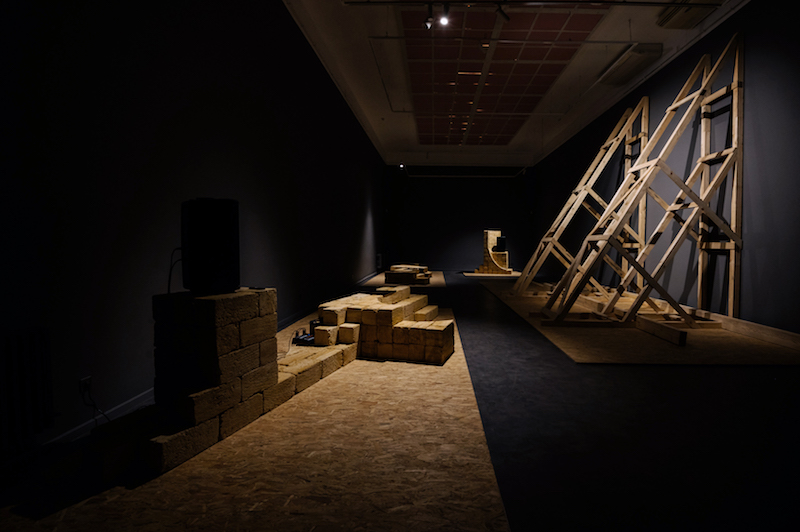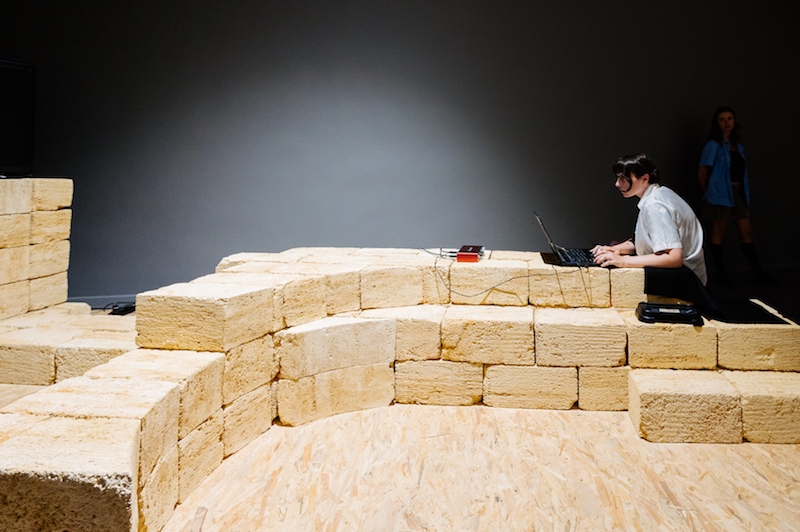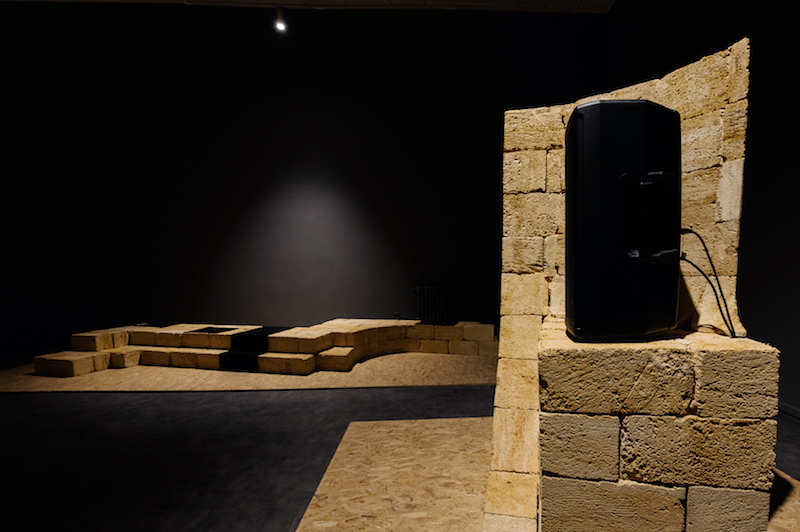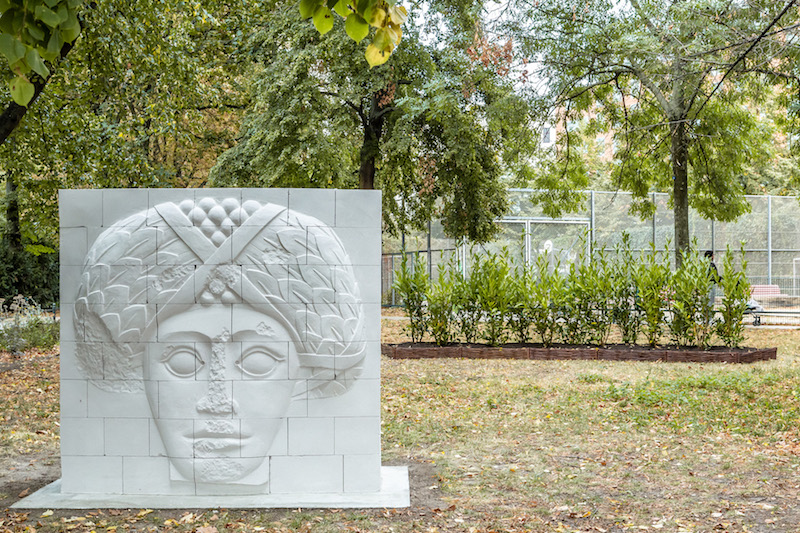by Dagmara Genda // Nov. 1, 2024
After four years of delays, Kandis Friesen’s ‘Archives at a time’ finally opened in the Odesa National Fine Arts Museum on August 16th, 2024. First postponed due to the pandemic, later held up by the ongoing war, what started as an investigation into the crumbling architecture of the Odesa State Archives building—itself a complex site of remembrance, erasure and oblivion—became inflected by the increasingly precarious reality of life in Ukraine. With the full-scale Russian invasion in 2022 (the offensive as such started with the annexation of Crimea in 2014), the entire country was thrown into a state of cultural triage. Today, the aesthetics of everyday life are decided by what to preserve and what to cast away—which damaged buildings to scaffold to keep from falling, how to function with prolonged power outages, where to enlist the constantly decreasing number of workers? These circumstances not only delayed, but shaped the very nature of the work that the artist eventually presented.
The existential crisis of war, its direct assault on official and personal memory, makes each citizen a member of the diaspora, where in end effect Friesen has always found her home. Born in Canada and now living in Berlin, her background is Ukrainian Mennonite, who themselves were Low German-speaking settlers in the Russian Empire, drawn east to escape the religious persecution of the late 1700s. Memory, as she writes in reference to her work ‘Diadéo trésor’ (2024-25) is “a process, continually learned and shaped, in need of resonant activation.” This activation resists the dogma of history positioning it as one artifice among many, and offers in its place a site of potential. Reflecting on nostalgia in relation to memory, Friesen notes, “I think I’m constantly making work for my grandparents—for their ghosts, anyway… Maybe that’s part of the nostalgia… I’m making work for some kind of past and some kind of future, and neither have ever existed.”

Kandis Friesen: ‘Archives at a time,’ 2024, installation view at Odesa National Fine Arts Museum // Photo by Ivan Strahov
Dagmara Genda: I am particularly interested in the role of memory in ‘Archives at a time,’ especially since you engage with your Ukrainian Mennonite heritage as a second generation Canadian, without remembering it yourself. What role does the interweaving of personal, official and imaginary memory play in your practice?
Kandis Friesen: I never felt a severing from my culture. Ukrainian (Kazakhstani, Russian, Soviet, etc.) Mennonite culture is not necessarily only tied to Ukraine—it’s carried, inherently diasporic. I grew up deeply immersed in the food, languages, faith, school, everything. My life was fully Mennonite (until I met punk rock).
My Canadian-born father also had an active relationship to Ukraine, even though many Mennonites emigrated, or were exiled, from their homes there. He is an architect and self-taught historian, and for years he travelled the southeast, taking Mennonites back to their home villages on these auto-ethnographic tours, documenting Mennonite architecture, and eventually writing a book on Ukrainian-Mennonite architectural history. My grandmother, from a village near Zaporizhzhia, was more like a mother to me, and she survived the revolution and related wars before immigrating to Canada.
Emerging within the 16th century radical reformation, the culture is inherently diasporic and dispersed, so that our oral language and song form the foundation of a portable homeland—a territory invoked through sound. I use this material-conceptual framework in my practice, this idea of resonance and dispersal, something that resists solidity, something one can carry, collective yet covert. In this way, the interweaving of different forms of memory is central to my practice, and I call this the dispersed monumental—dispersed forms of memory that reside in architectures or structures or sites, in land/scapes, objects, gestures or songs.

Kandis Friesen: ‘Archives at a time,’ 2024, Hanna Bryzhata performing at Odesa National Fine Arts Museum // Photo by Ivan Strahov
DG: The wooden and stone structures in the show in Odesa, though bearing direct relation to the structure of the building, remind me of constructivist theatre stage sets. Was this a conscious reference and is there a nostalgia present here as well?
KF: Absolutely, the constructivist theatre set is a conscious reference here, developed with the performance of the commissioned sound works in mind. But it also stems directly from the building’s scaffolding and temporality—the sense of something about to happen, or something just ending, a post/anticipation sense of time.
Many of the elements you mention are also a direct or indirect result of the war, as electricity, materials, specialized knowledge and labour are strained or non-existent. The hall’s skylights are covered for protection, the walls were left this dark grey, the lighting is simple and easily mimicked with flashlights. The exhibition was produced during ongoing shelling and short periods of electricity, with labour hard to find due to both the war draft and draft evasion. As a team, we folded these conditions into our work, with the curator and my colleagues in Odesa working intensively to realize the exhibition in responsive ways.
I’ve been developing this body of work since 2016, and it was already deeply resonant with the ruptures of war, as well as the constructivist ethos of provisional assemblage, off-centre directionalities and architectural montage. The relationship between time and structure permeates my practice, and my works are somehow alphabetic and modular in their grammar: they may take a certain form, but it’s clear that they could be re-assembled in a different way, like language or song. This is another way that my work is shaped by the sonic, anchored in the dispersed and diasporic oral language and aural architecture of choral singing that formed my world growing up.

Kandis Friesen: ‘Archives at a time,’ 2024, installation view at Odesa National Fine Arts Museum // Photo by Ivan Strahov
DG: In many of your installations the “artifice” has a prominent aesthetic function. While there is a connection to architecture and construction sites, I am interested in the connection to the artificial and the association to the theatre set.
KF: A recurring strategy in my work is to compose a structure that is aware of its own construction, and shares that awareness, in different ways. Another name for this is montage: a movement through an assemblage. So I relate your question to the way that I use montage in my work, which highlights performativity and asks questions about one’s experience of the construction, or structure. How do we move through it, and how does it move through us? How do we co-construct it, and how does it co-construct us? This puts the focus on the structure itself, and an awareness of the processes and relations it produces. The theatre set does this very clearly, and the constructivist theatre set even more so: here we are, gathering in this structure and this temporality, and isn’t this also, possibly, the structure and temporality of the world? Can we make it so?

Kandis Friesen: ‘Diadéo Trésor,’ 2024-25 // Photo by Laura Fiorio
DG: In relation to your recent project, ‘Diadéo trésor,’ you write about memory being in need of “resonant activation.” Can you talk about what that can be?
KF: When memory is solidified, such as in a monument or an official history, it often produces a cut, a separation from the flow of time and from the complex relations around it. Returning again to provisionality, memory as a process requires us to be present, to negotiate its meaning in the complex world it inhabits, across time and context. As Michel-Rolf Trouillot writes, in ‘Silencing the Past,’ historical production is itself historical, and only from this knowledge can we remain in present and active relation to it. Rather than accumulating knowledge of separated and sanitized histories, it is vital to maintain an active relation with history, through a process of continual return. I learn this from the practices of artists, poets and filmmakers like Kamal Aljafari, Basel Abbas and Ruanne Abou-Rahme, Etel Adnan, Nadia Myre, Leanne Betasamosake Simpson, Michael Rakowitz, and many others—how to return, again and again, to the construction of histories in the present, to each other.
In the context of ‘Diadéo trésor,’ I invited several artists to respond to my installation, itself an anchor for the intersection of multiple muted and hyper-present histories along Leipziger Strasse in Berlin. Their sound installations, workshops and walking tours have made beautiful and unexpected connections, amplifying the intersection of these histories through gathering, researching, listening, talking, learning, walking and looking. In simple terms, resonant activation is one way of saying we need to be together, to maintain our relationships to histories in the present, through our relations to one another and the world, in solidarity. As the ongoing brutal destruction in Palestine and Lebanon, in Ukraine, Haiti and Sudan continues, it is desperately urgent work.

Kandis Friesen: ‘Diadéo Trésor,’ 2024-25, listening session at vernissage // Photo by Piotr Pietrus
DG: Can you talk about the challenge of coalescing the branching avenues of an archive and its seemingly endless opening of research possibilities into an exhibition or a work of art?
KF: One way I respond to the possible archival deluge is to produce my own work as a series of experimental archives, experimental fonds, in shifting constellations—cyclical, fragmented and dispersed. I’m drawn to archival breakdown and disrepair, and building within those displacements, where the seemingly endless opening of possibilities hits up against containment and breaks down through rupture. I often realize my work through grafting, a kind of collage that acknowledges the structure it extends from, while producing connected yet divergent outcomes. In this sense, I connect my work loosely to folk art, and I draw here on Stuart Hall’s articulation of the (complicated) term: an art aware of its lineage; that uses its immediate materials; that is somehow collectively-authored; that is carried, transmitted and transformed. This kind of transmission is perhaps clearest in music—my main influence and metier until I went to art school later in life—where transposition, citation and remix are fluid and present, often encouraged and embraced.
In my exhibition in Odesa, I’ve grafted the archive building’s material-conceptual structure and fragmented architectures, and sounds into the space of the museum, inviting sound artists to compose within and for my composition, who in turn worked with choral structures and the material-conceptual nature of Odesa limestone to produce their works, returning a (displaced) resonance to the synagogue’s formerly resonant and musical reverberant space. This is the kind of cyclical return I was speaking about earlier, one changed by every revolution, building itself in relation to the changed present.
Artist Info
Exhibition Info
Odesa National Fine Arts Museum
Kandis Friesen: ‘Archives at a time’
Exhibition: Aug. 16-Nov. 24, 2024
ofam.ua
Sofiivs’ka St, 5А, Odesa, Ukraine, 65000, click here for map
TIER Space
Group Show: ‘The Shape of a Pocket’
Exhibition: Nov. 1-10, 2024
theinstituteforendoticresearch.org
Donaustraße 84, 12043 Berlin, click here for map




















